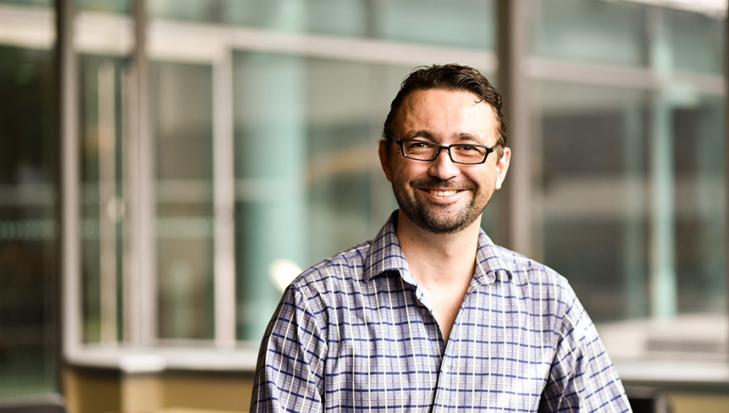
Collaborative research with undergraduates has proven fruitful for Assistant Professor Nicholas Harrigan, leading to publications in top-flight journals.

Photo Credit: Cyril Ng
By Rebecca Tan
SMU Office of Research – From the playground to the world political stage, human interactions are governed by what are called signed ties—positive or negative relationships within a social network. In the context of the playground, for example, friendship is considered a positive tie while bullying is negative. Similarly, alliances and disputes between countries can be interpreted as positive and negative ties respectively.
Despite their ubiquity and importance in both personal and public interactions, much of our understanding of signed ties has focused only on positive ties. In fact, says Assistant Professor Nicholas Harrigan from the School of Social Sciences at the Singapore Management University (SMU), the study of signed ties has been dominated by a single theory over the last 60 years: balance theory.
“The basic idea of balance theory is that humans like to take sides; they don’t like to have cognitive dissonance. Therefore, when two of their friends are in conflict with one another they tend to take sides with one or the other,” he explains. “Although there was some evidence for this, many articles showed that balance was only a weak effect. However, no one had any idea of what to replace it with.”
The situation changed in 2010, when researchers came up with a theory called status theory. Under this paradigm, people send positive ties to people who are of higher status than themselves and negative ties to those of lower status. “We wanted to test the two competing theories of balance and status on a really good dataset, to see if there were any third or fourth mechanisms at work with negative ties,” Professor Harrigan shares. “Then we realised that we already had excellent access to research subjects: students.”
The triumvirate of negativity
In 2013, Professor Harrigan and his student collaborator Ms Janice Yap surveyed social science students at SMU, asking them questions on positive ties such as who they would go to lunch with or nominate for student elections, and also on negative ties, such as whom they would avoid having lunch with or not nominate for student elections.
“Through asking these questions, we were able to derive the social network, which we then modelled. Using a cutting edge method in social network analysis called exponential random graph modelling (ERGM), we ran thousands of simulations of the network and millions of simulations of the ties to see what parameters best reproduced the network we observed,” he says.
The results, however, turned up 50 significant parameters for each of their two models on friendships and status, making it difficult to interpret. Undeterred, Professor Harrigan came up with a series of competing theories and calculated predictions on whether each parameter would have a positive, negative or no effect.
“Once we’d done that, we still had two tables of 450 predictions each. So we reduced the complexity of the data using factor analysis and tried to see whether there were commonalities in what they were predicting. What we found was that there were ultimately three dimensions to the theories that explained negative ties,” he says.
Balance theory and status theory each explained about 20 to 30 percent of the variance in negative ties, along with a third dimension, called homophily, which is the tendency to like people that are similar to us and dislike people that are different to us. “We called them the triumvirate, the three dominant social forces which shaped whether you dislike someone,” he says.
Professor Harrigan’s work on the triumvirate of negative ties was recently published in the top ranked journal Social Networks, the successful outcome of a project that began as an undergraduate independent study unit.
The mental health of migrant workers
In fact, collaborating with students has also led him into fruitful new research areas. Due to student interest in the topic and his own passion for social issues, Professor Harrigan has gone into research on migrant workers in Singapore and he now has half a dozen ongoing projects at different stages of completion.
“Migrant workers in Singapore are a critical issue for the government and for society in general: there are about 1.3 million foreign workers in Singapore, making up about a third of the workforce. Just under a million of these workers are low-waged workers, with a considerable number of social issues,” he points out.
One of his first studies, a survey on the mental health of migrant workers, was done in collaboration with SMU undergraduate Ms Koh Chiu Yee. They surveyed 600 injured and regular workers on the streets of Little India and correlated their mental health outcomes with socioeconomic factors.
“The good news is that regular migrant workers are quite happy overall,” Professor Harrigan says. “However, when we surveyed the workers at a soup kitchen run by a non-governmental organisation in Singapore, we found that about two thirds of them met the screening critieria for a serious mental illness.”
He adds, “We used a simple screening test – called the K6 – which was developed at Harvard University and which is widely used in the academic literature. This allowed us to estimate how many of the workers were more likely than not to be suffering from a serious mental illness, such as depression or anxiety, and that this illness is likely to be serious enough to impair their ability to function in at least one major area of their life.”
“The workers who were likely affected by serious mental illness were mostly injured workers and people who had salary claims problems with their employers. About 65 percent of workers with injuries or salary claims met the criteria for screening for a serious mental illness; in comparison, only 4 percent of the US population and 12 percent of the non-injured workers did.”
“When we ran our modelling on both groups, the main thing we found that drove emotional distress was threats of repatriation; it had quite a large and statistically significant effect on their levels of emotional distress. Amongst the regular workers, agent fee debt also lead to higher levels of emotional distress,” he says.
At the moment, Professor Harrigan is working on doing a randomised sample of migrant workers that avoids the statistical biases of location-based sampling. Supported by research funding from SMU and the Ministry of Education (MOE), he plans to reach about 1,000 migrant workers from a “mini call centre” run by students from the required language backgrounds.
“As a social scientist, my job is to shed some light on what the facts are in relation to issues like migrant workers,” he remarks. “I hope that the information I am able to generate is taken seriously by the public and policy makers.”
See More News
Want to see more of SMU Research?
Sign up for Research@SMU e-newslettter to know more about our research and research-related events!
If you would like to remove yourself from all our mailing list, please visit https://eservices.smu.edu.sg/internet/DNC/Default.aspx
